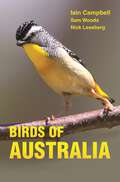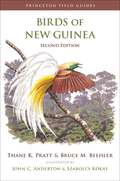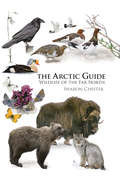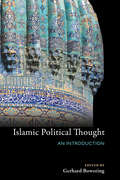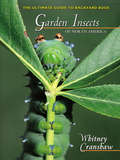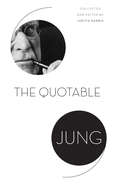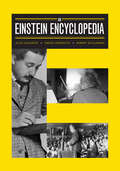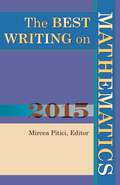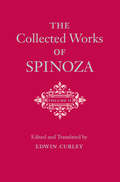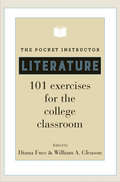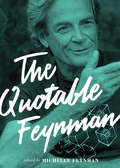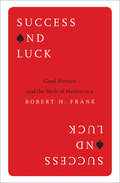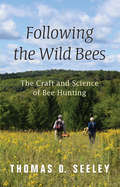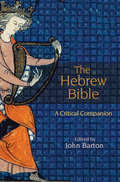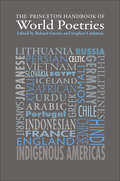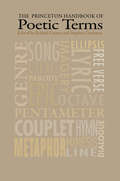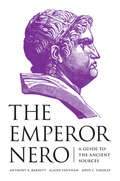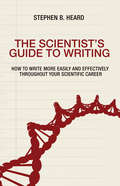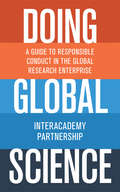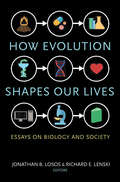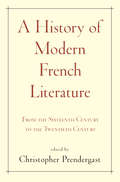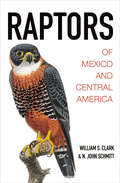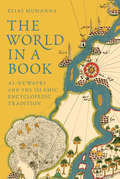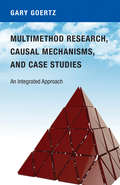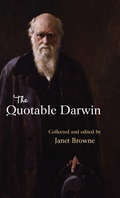- Table View
- List View
Birds of Australia: A Photographic Guide
by Iain Campbell Sam Woods Nick LesebergThe best photographic field guide to Australia's birdsAustralia is home to a spectacular diversity of birdlife, from parrots and penguins to emus and vibrant passerines. Birds of Australia covers all 714 species of resident birds and regularly occurring migrants and features more than 1,100 stunning color photographs, including many photos of subspecies and plumage variations never before seen in a field guide. Detailed facing-page species accounts describe key identification features such as size, plumage, distribution, behavior, and voice. This one-of-a-kind guide also provides extensive habitat descriptions with a large number of accompanying photos. The text relies on the very latest IOC taxonomy and the distribution maps incorporate the most current mapping data, making this the most up-to-date guide to Australian birds.Covers all 714 species of resident birds and regularly occurring migrantsFeatures more than 1,100 stunning color photosIncludes facing-page species accounts, habitat descriptions, and distribution mapsThe ideal photographic guide for beginners and seasoned birders alike
Birds of New Guinea: Second Edition (Princeton Field Guides #97)
by Thane K. Pratt Bruce M. BeehlerThe definitive field guide to the marvelous birds of New GuineaThis is the completely revised edition of the essential field guide to the birds of New Guinea. The world's largest tropical island, New Guinea boasts a spectacular avifauna characterized by cassowaries, megapodes, pigeons, parrots, cuckoos, kingfishers, and owlet-nightjars, as well as an exceptionally diverse assemblage of songbirds such as the iconic birds of paradise and bowerbirds. Birds of New Guinea is the only guide to cover all 780 bird species reported in the area, including 366 endemics. Expanding its coverage with 111 vibrant color plates—twice as many as the first edition—and the addition of 635 range maps, the book also contains updated species accounts with new information about identification, voice, habits, and range. A must-have for everyone from ecotourists to field researchers, Birds of New Guinea remains an indispensable guide to the diverse birds of this remarkable region.780 bird species, including 366 found nowhere else111 stunning color plates, twice the number of the first editionExpanded and updated species accounts provide details on identification, voice, habits, and range635 range mapsRevised classification of birds reflects the latest research
The Arctic Guide: Wildlife of the Far North
by Sharon ChesterThe Arctic Guide presents the traveler and naturalist with a portable, authoritative guide to the flora and fauna of earth's northernmost region. Featuring superb color illustrations, this one-of-a-kind book covers the complete spectrum of wildlife--more than 800 species of plants, fishes, butterflies, birds, and mammals--that inhabit the Arctic's polar deserts, tundra, taiga, sea ice, and oceans. It can be used anywhere in the entire Holarctic region, including Norway's Svalbard archipelago, Siberia, the Russian Far East, islands of the Bering Sea, Alaska, the Canadian Arctic, and Greenland. Detailed species accounts describe key identification features, size, habitat, range, scientific name, and the unique characteristics that enable these organisms to survive in the extreme conditions of the Far North. A color distribution map accompanies each species account, and alternative names in German, French, Norwegian, Russian, Inuit, and Inupiaq are also provided. Features superb color plates that allow for quick identification of more than 800 species of plants, fishes, butterflies, birds, and mammals Includes detailed species accounts and color distribution maps Covers the flora and fauna of the entire Arctic region
Islamic Political Thought
by Gerhard BoweringIn sixteen concise chapters on key topics, this book provides a rich, authoritative, and up-to-date introduction to Islamic political thought from the birth of Islam to today, presenting essential background and context for understanding contemporary politics in the Islamic world and beyond. Selected from the acclaimed Princeton Encyclopedia of Islamic Political Thought, and focusing on the origins, development, and contemporary importance of Islamic political ideas and related subjects, each chapter offers a sophisticated yet accessible introduction to its topic. Written by leading specialists and incorporating the latest scholarship, the alphabetically arranged chapters cover the topics of authority, the caliphate, fundamentalism, government, jihad, knowledge, minorities, modernity, Muhammad, pluralism and tolerance, the Qur'an, revival and reform, shariʿa (sacred law), traditional political thought, 'ulama' (religious scholars), and women. Read separately or together, these chapters provide an indispensable resource for students, journalists, policymakers, and anyone else seeking an informed perspective on the complex intersection of Islam and politics.The contributors are Gerhard Bowering, Ayesha S. Chaudhry, Patricia Crone, Roxanne Euben, Yohanan Friedmann, Paul L. Heck, Roy Jackson, Wadad Kadi, John Kelsay, Gudrun Krämer, Ebrahim Moosa, Armando Salvatore, Aram A. Shahin, Emad El-Din Shahin, Devin J. Stewart, SherAli Tareen, and Muhammad Qasim Zaman.A new afterword discusses the essays in relation to contemporary political developments.
Garden Insects of North America
by Whitney CranshawGarden Insects of North America is the most comprehensive and user-friendly guide to the common insects and mites affecting yard and garden plants in North America. In a manner no previous book has come close to achieving, through full-color photos and concise, clear, scientifically accurate text, it describes the vast majority of species associated with shade trees and shrubs, turfgrass, flowers and ornamental plants, vegetables, and fruits--1,420 of them, including crickets, katydids, fruit flies, mealybugs, moths, maggots, borers, aphids, ants, bees, and many, many more. For particularly abundant bugs adept at damaging garden plants, management tips are also included. Covering all of the continental United States and Canada, this is the definitive one-volume resource for amateur gardeners, insect lovers, and professional entomologists alike. To ease identification, the book is organized by plant area affected (e.g., foliage, flowers, stems) and within that, by taxa. Close to a third of the species are primarily leaf chewers, with about the same number of sap suckers. Multiple photos of various life stages and typical plant symptoms are included for key species. The text, on the facing page, provides basic information on host plants, characteristic damage caused to plants, distribution, life history, habits, and, where necessary, how to keep "pests" in check--in short, the essentials to better understanding, appreciating, and tolerating these creatures. Whether managing, studying, or simply observing insects, identification is the first step--and this book is the key. With it in hand, the marvelous microcosm right outside the house finally comes fully into view. Describes more than 1,400 species--twice as many as in any other field guide Full-color photos for most species--more than five times the number in most comparable guides Up-to-date pest management tips Organized by plant area affected and by taxa for easy identification Covers the continental United States and Canada Provides species level treatment of all insects and mites important to gardens Illustrates all life stages of key garden insects and commonly associated plant injuries Concise, clear, scientifically accurate text Comprehensive and user-friendly
The Quotable Jung
by Judith Harris Tony Woolfson C. G. JungC. G. Jung (1875-1961) was a preeminent thinker of the modern era. In seeking to establish an interdisciplinary science of analytical psychology, he studied psychiatry, religion, mysticism, literature, physics, biology, education, and criminology. He introduced the concepts of extraversion and introversion, and terms such as complex, archetype, individuation, and the collective unconscious. He stressed the primacy of finding meaning in our lives.The Quotable Jung is the single most comprehensive collection of Jung quotations ever assembled. It is the essential introduction for anyone new to Jung and the Jungian tradition. It will also inspire those familiar with Jung to view him in an entirely new way. The Quotable Jung presents hundreds of the most representative selections from the vast array of Jung's books, essays, correspondence, lectures, seminars, and interviews, as well as the celebrated Red Book, in which Jung describes his own fearsome confrontation with the unconscious. Organized thematically, this collection covers such topics as the psyche, the symbolic life, dreams, the analytic process, good and evil, creativity, alchemical transformation, death and rebirth, the problem of the opposites, and more. The quotations are arranged so that the reader can follow the thread of Jung's thought on these topics while gaining an invaluable perspective on his writings as a whole.Succinct and accessible, The Quotable Jung also features a preface by Judith Harris and a detailed chronology of Jung's life and work.The single most comprehensive collection of Jung quotations ever assembledFeatures hundreds of quotesCovers such topics as the psyche, dreams, good and evil, death and rebirth, and moreIncludes a detailed chronology of Jung's life and workServes as the ideal introduction to Jung and the Jungian tradition
An Einstein Encyclopedia
by Daniel Kennefick Robert Schulmann Alice CalapriceThis is the single most complete guide to Albert Einstein's life and work for students, researchers, and browsers alike. Written by three leading Einstein scholars who draw on their combined wealth of expertise gained during their work on the Collected Papers of Albert Einstein, this authoritative and accessible reference features more than one hundred entries and is divided into three parts covering the personal, scientific, and public spheres of Einstein's life.An Einstein Encyclopedia contains entries on Einstein's birth and death, family and romantic relationships, honors and awards, educational institutions where he studied and worked, citizenships and immigration to America, hobbies and travels, plus the people he befriended and the history of his archives and the Einstein Papers Project. Entries on Einstein's scientific theories provide useful background and context, along with details about his assistants, collaborators, and rivals, as well as physics concepts related to his work. Coverage of Einstein's role in public life includes entries on his Jewish identity, humanitarian and civil rights involvements, political and educational philosophies, religion, and more.Commemorating the hundredth anniversary of the theory of general relativity, An Einstein Encyclopedia also includes a chronology of Einstein's life and appendixes that provide information for further reading and research, including an annotated list of a selection of Einstein's publications and a review of selected books about Einstein.More than 100 entries cover the rich details of Einstein's personal, professional, and public lifeAuthoritative entries explain Einstein's family relationships, scientific achievements, political activities, religious views, and moreMore than 40 illustrations include photos of Einstein and his circle plus archival materialsA chronology of Einstein's life, appendixes, and suggestions for further reading provide essential details for further research
The Best Writing on Mathematics 2015 (The Best Writing on Mathematics #14)
by Mircea PiticiThe year's finest writing on mathematics from around the worldThis annual anthology brings together the year's finest mathematics writing from around the world. Featuring promising new voices alongside some of the foremost names in the field, The Best Writing on Mathematics 2015 makes available to a wide audience many articles not easily found anywhere else—and you don’t need to be a mathematician to enjoy them. These writings offer surprising insights into the nature, meaning, and practice of mathematics today. They delve into the history, philosophy, teaching, and everyday occurrences of math, and take readers behind the scenes of today’s hottest mathematical debates.Here David Hand explains why we should actually expect unlikely coincidences to happen; Arthur Benjamin and Ethan Brown unveil techniques for improvising custom-made magic number squares; Dana Mackenzie describes how mathematicians are making essential contributions to the development of synthetic biology; Steven Strogatz tells us why it’s worth writing about math for people who are alienated from it; Lisa Rougetet traces the earliest written descriptions of Nim, a popular game of mathematical strategy; Scott Aaronson looks at the unexpected implications of testing numbers for randomness; and much, much more.In addition to presenting the year’s most memorable writings on mathematics, this must-have anthology includes a bibliography of other notable writings and an introduction by the editor, Mircea Pitici. This book belongs on the shelf of anyone interested in where math has taken us—and where it is headed.
The Collected Works of Spinoza, Volume II: One-volume Digital Edition
by Benedictus de SpinozaThe second and final volume of the most authoritative English-language edition of Spinoza's writingsThe Collected Works of Spinoza provides, for the first time in English, a truly satisfactory edition of all of Spinoza's writings, with accurate and readable translations, based on the best critical editions of the original-language texts, done by a scholar who has published extensively on the philosopher's work.The centerpiece of this second volume is Spinoza’s Theological-Political Treatise, a landmark work in the history of biblical scholarship, the first argument for democracy by a major philosopher, and a forceful defense of freedom of thought and expression. This work is accompanied by Spinoza’s later correspondence, much of which responds to criticism of the Theological-Political Treatise. The volume also includes his last work, the unfinished Political Treatise, which builds on the foundations of the Theological-Political Treatise to offer plans for the organization of nontyrannical monarchies and aristocracies.The elaborate editorial apparatus—including prefaces, notes, glossary, and indexes—assists the reader in understanding one of the world’s most fascinating, but also most difficult, philosophers. Of particular interest is the glossary-index, which provides extensive commentary on Spinoza’s technical vocabulary.A milestone of scholarship more than forty-five years in the making, The Collected Works of Spinoza is an essential edition for anyone with a serious interest in Spinoza or the history of philosophy.
The Pocket Instructor: Literature
by William A. Gleason Diana FussThis is the first comprehensive collection of hands-on, active learning exercises for the college literature classroom, offering ideas and inspiration for new and veteran teachers alike. These 101 surefire lesson plans present creative and interactive activities to get all your students talking and learning, from the first class to final review. Whether you are teaching majors or nonmajors, genres or periods, canonical or noncanonical literature, medieval verse or the graphic novel, this volume provides practical and flexible exercises for creating memorable learning experiences. Help students learn more and retain that knowledge longer by teaching them how to question, debate, annotate, imitate, write, draw, map, stage, or perform. These user-friendly exercises feature clear and concise step-by-step instructions, and each exercise is followed by helpful teaching tips and descriptions of the exercise in action. All encourage collaborative learning and many are adaptable to different class sizes or course levels. A collection of successful approaches for teaching fiction, poetry, and drama and their historical, cultural, and literary contexts, this indispensable book showcases the tried and true alongside the fresh and innovative.101 creative classroom exercises for teaching literatureExercises contributed by experienced teachers at a wide range of colleges and universitiesStep-by-step instructions and teaching tips for each exerciseExtensive introduction on the benefits of bringing active learning to the literature classroomCross-references for finding further exercises and to aid course planningIndex of literary authors, works, and related topics
The Quotable Feynman
by Yo-Yo Ma Brian Cox Richard P. Feynman Michelle Feynman"Some people say, 'How can you live without knowing?' I do not know what they mean. I always live without knowing. That is easy. How you get to know is what I want to know."--Richard P. FeynmanNobel Prize-winning physicist Richard P. Feynman (1918-88) was that rarest of creatures--a towering scientific genius who could make himself understood by anyone and who became as famous for the wit and wisdom of his popular lectures and writings as for his fundamental contributions to science. The Quotable Feynman is a treasure-trove of this revered and beloved scientist's most profound, provocative, humorous, and memorable quotations on a wide range of subjects.Carefully selected by Richard Feynman's daughter, Michelle Feynman, from his spoken and written legacy, including interviews, lectures, letters, articles, and books, the quotations are arranged under two dozen topics--from art, childhood, discovery, family, imagination, and humor to mathematics, politics, science, religion, and uncertainty. These brief passages--about 500 in all--vividly demonstrate Feynman's astonishing yet playful intelligence, and his almost constitutional inability to be anything other than unconventional, engaging, and inspiring. The result is a unique, illuminating, and enjoyable portrait of Feynman's life and thought that will be cherished by his fans at the same time that it provides an ideal introduction to Feynman for readers new to this intriguing and important thinker.The book features a foreword in which physicist Brian Cox pays tribute to Feynman and describes how his words reveal his particular genius, a piece in which cellist Yo-Yo Ma shares his memories of Feynman and reflects on his enduring appeal, and a personal preface by Michelle Feynman. It also includes some previously unpublished quotations, a chronology of Richard Feynman's life, some twenty photos of Feynman, and a section of memorable quotations about Feynman from other notable figures.Features:Approximately 500 quotations, some of them previously unpublished, arranged by topicA foreword by Brian Cox, reflections by Yo-Yo Ma, and a preface by Michelle FeynmanA chronology of Feynman's lifeSome twenty photos of FeynmanA section of quotations about Feynman from other notable figuresSome notable quotations of Richard P. Feynman:"The thing that doesn't fit is the most interesting.""Thinking is nothing but talking to yourself inside.""It is wonderful if you can find something you love to do in your youth which is big enough to sustain your interest through all your adult life. Because, whatever it is, if you do it well enough (and you will, if you truly love it), people will pay you to do what you want to do anyway.""I'd hate to die twice. It's so boring."
Success and Luck: Good Fortune and the Myth of Meritocracy
by Robert H. FrankHow important is luck in economic success? No question more reliably divides conservatives from liberals. As conservatives correctly observe, people who amass great fortunes are almost always talented and hardworking. But liberals are also correct to note that countless others have those same qualities yet never earn much. In recent years, social scientists have discovered that chance plays a much larger role in important life outcomes than most people imagine. In Success and Luck, bestselling author and New York Times economics columnist Robert Frank explores the surprising implications of those findings to show why the rich underestimate the importance of luck in success--and why that hurts everyone, even the wealthy.Frank describes how, in a world increasingly dominated by winner-take-all markets, chance opportunities and trivial initial advantages often translate into much larger ones--and enormous income differences--over time; how false beliefs about luck persist, despite compelling evidence against them; and how myths about personal success and luck shape individual and political choices in harmful ways.But, Frank argues, we could decrease the inequality driven by sheer luck by adopting simple, unintrusive policies that would free up trillions of dollars each year--more than enough to fix our crumbling infrastructure, expand healthcare coverage, fight global warming, and reduce poverty, all without requiring painful sacrifices from anyone. If this sounds implausible, you'll be surprised to discover that the solution requires only a few, noncontroversial steps.Compellingly readable, Success and Luck shows how a more accurate understanding of the role of chance in life could lead to better, richer, and fairer economies and societies.
Following the Wild Bees: The Craft and Science of Bee Hunting
by Thomas D. SeeleyFollowing the Wild Bees is a delightful foray into the pastime of bee hunting, an exhilarating outdoor activity that used to be practiced widely but which few people know about today. Thomas Seeley, a world authority on honey bees, vividly describes the history and science behind this lost pastime and how anyone can do it. Following the Wild Bees is both a unique meditation on the pleasures of the natural world and a guide to the ingenious methods that compose the craft of the bee hunter.Seeley explains how one finds a patch of flowers humming with honey bees, captures and sumptuously feeds the bees, and then releases and follows them, step-by-step in whatever direction they fly, back to their secret residence in a hollow tree, old building, or abandoned hive. The bee hunter's reward is a thrilling encounter with nature that challenges mind and body while also giving new insights into the remarkable behavior of honey bees living in the wild.Drawing on decades of experience as a bee hunter and bee biologist, Seeley weaves informative discussions of the biology of wild honey bees with colorful historical anecdotes, personal insights, and beautiful photos. Whether you're a bee enthusiast or just curious about the natural world, Following the Wild Bees is the ideal companion for newcomers to bee hunting and a rare treat for armchair naturalists.
The Hebrew Bible: A Critical Companion
by John BartonThis book brings together some of the world's most exciting scholars from across a variety of disciplines to provide a concise and accessible guide to the Hebrew Bible. It covers every major genre of book in the Old Testament together with in-depth discussions of major themes such as human nature, covenant, creation, ethics, ritual and purity, sacred space, and monotheism. This authoritative overview sets each book within its historical and cultural context in the ancient Near East, paying special attention to its sociological setting. It provides new insights into the reception of the books and the different ways they have been studied, from historical-critical enquiry to modern advocacy approaches such as feminism and liberation theology. It also includes a guide to biblical translations and textual criticism and helpful suggestions for further reading.Featuring contributions from experts with backgrounds in the Jewish and Christian faith traditions as well as secular scholars in the humanities and social sciences, The Hebrew Bible is the perfect starting place for anyone seeking a user-friendly introduction to the Old Testament, and an invaluable reference book for students and teachers.
The Princeton Handbook of World Poetries
by Roland Greene Stephen CushmanThe Princeton Handbook of World Poetries--drawn from the latest edition of the acclaimed Princeton Encyclopedia of Poetry and Poetics--provides a comprehensive and authoritative survey of the history and practice of poetry in more than 100 major regional, national, and diasporic literatures and language traditions around the globe. With more than 165 entries, the book combines broad overviews and focused accounts to give extensive coverage of poetic traditions throughout the world. For students, teachers, researchers, poets, and other readers, it supplies a one-of-a-kind resource, offering in-depth treatment of Indo-European poetries (all the major Celtic, Slavic, Germanic, and Romance languages, and others); ancient Middle Eastern poetries (Hebrew, Persian, Sumerian, and Assyro-Babylonian); subcontinental Indian poetries (Bengali, Hindi, Marathi, Punjabi, Sanskrit, Tamil, Urdu, and more); Asian and Pacific poetries (Chinese, Japanese, Korean, Vietnamese, Mongolian, Nepalese, Thai, and Tibetan); Spanish American poetries (those of Mexico, Peru, Argentina, Chile, and many other Latin American countries); indigenous American poetries (Guaraní, Inuit, and Navajo); and African poetries (those of Ethiopia, Somalia, South Africa, and other countries, and including African languages, English, French, and Portuguese). Complete with an introduction by the editors, this is an essential volume for anyone interested in understanding poetry in an international context.Drawn from the latest edition of the acclaimed Princeton Encyclopedia of Poetry and PoeticsProvides more than 165 authoritative entries on poetry in more than 100 regional, national, and diasporic literatures and language traditions throughout the worldFeatures extensive coverage of non-Western poetic traditionsIncludes an introduction, bibliographies, cross-references, and a general index
The Princeton Handbook of Poetic Terms: Third Edition
by Roland Greene Stephen CushmanThe Princeton Handbook of Poetic Terms--drawn from the latest edition of the acclaimed Princeton Encyclopedia of Poetry and Poetics--provides an authoritative guide to the most important terms in the study of poetry and literature. Featuring 226 fully revised and updated entries, including 100 that are new to this edition, the book offers clear and insightful definitions and discussions of critical concepts, genres, forms, movements, and poetic elements, followed by invaluable, up-to-date bibliographies that guide users to further reading and research. Because the entries are carefully selected and adapted from the Princeton Encyclopedia, the Handbook has unrivalled breadth and depth for a book of its kind, in a convenient, portable size. Fully indexed for the first time and complete with an introduction by the editors, this is an essential volume for all literature students, teachers, and researchers, as well as other readers and writers.Drawn from the latest edition of the acclaimed Princeton Encyclopedia of Poetry and PoeticsProvides 226 fully updated and authoritative entries, including 100 new to this edition, written by an international team of leading scholarsFeatures entries on critical concepts (canon, mimesis, prosody, syntax); genres, forms, and movements (ballad, blank verse, confessional poetry, ode); and terms (apostrophe, hypotaxis and parataxis, meter, tone)Includes an introduction, bibliographies, cross-references, and a full index
The Emperor Nero: A Guide to the Ancient Sources
by John C. Yardley Anthony A. Barrett Elaine FanthamNero's reign (AD 54-68) witnessed some of the most memorable events in Roman history, such as the rebellion of Boudica and the first persecution of the Christians--not to mention Nero's murder of his mother, his tyranny and extravagance, and his suicide, which plunged the empire into civil war. The Emperor Nero gathers into a single collection the major sources for Nero's life and rule, providing students of Nero and ancient Rome with the most authoritative and accessible reader there is.The Emperor Nero features clear, contemporary translations of key literary sources along with translations and explanations of representative inscriptions and coins issued under Nero. The informative introduction situates the emperor's reign within the history of the Roman Empire, and the book's concise headnotes to chapters place the source material in historical and biographical context. Passages are accompanied by detailed notes and are organized around events, such as the Great Fire of Rome, or by topic, such as Nero's relationships with his wives. Complex events like the war with Parthia--split up among several chapters in Tacitus's Annals--are brought together in continuous narratives, making this the most comprehensible and user-friendly sourcebook on Nero available.Some images inside the book are unavailable due to digital copyright restrictions.
The Scientist's Guide to Writing: How to Write More Easily and Effectively throughout Your Scientific Career
by Stephen B. HeardThe ability to write clearly is critical to any scientific career. The Scientist's Guide to Writing provides practical advice to help scientists become more effective writers so that their ideas have the greatest possible impact.Drawing on his own experience as a scientist, graduate adviser, and editor, Stephen Heard emphasizes that the goal of all scientific writing should be absolute clarity; that good writing takes deliberate practice; and that what many scientists need are not long lists of prescriptive rules but rather direct engagement with their behaviors and attitudes when they write. He combines advice on such topics as how to generate and maintain writing momentum with practical tips on structuring a scientific paper, revising a first draft, handling citations, responding to peer reviews, managing coauthorships, and more.In an accessible, informal tone, The Scientist's Guide to Writing explains essential techniques that students, postdoctoral researchers, and early-career scientists need to write more clearly, efficiently, and easily.Emphasizes writing as a process, not just a productEncourages habits that improve motivation and productivityExplains the structure of the scientific paper and the function of each partProvides detailed guidance on submission, review, revision, and publicationAddresses issues related to coauthorship, English as a second language, and more
Doing Global Science
by Interacademy PartnershipThis concise introductory guide explains the values that should inform the responsible conduct of scientific research in today's global setting. Featuring accessible discussions and ample real-world scenarios, Doing Global Science covers proper conduct, fraud and bias, the researcher's responsibilities to society, communication with the public, and much more. The book places special emphasis on the international and highly networked environment in which modern research is done, presenting science as an enterprise that is being transformed by globalization, interdisciplinary research projects, team science, and information technologies.Accessibly written by an InterAcademy Partnership committee comprised of leading scientists from around the world, Doing Global Science is required reading for students, practitioners, and anyone concerned about the responsible conduct of science today.Provides practical guidance and instructions for doing scientific research in today's global setting Covers everything from responsible conduct to communication with the public Features numerous real-world scenarios drawn from an array of disciplines and national contexts Focuses on issues commonly encountered in international collaborations Written by a panel of leading experts from around the world An essential guide for practicing scientists and anyone concerned about fostering research integrity
How Evolution Shapes Our Lives: Essays on Biology and Society
by Richard E. Lenski Jonathan B. LososIt is easy to think of evolution as something that happened long ago, or that occurs only in "nature," or that is so slow that its ongoing impact is virtually nonexistent when viewed from the perspective of a single human lifetime. But we now know that when natural selection is strong, evolutionary change can be very rapid. In this book, some of the world's leading scientists explore the implications of this reality for human life and society. With some twenty-three essays, this volume provides authoritative yet accessible explorations of why understanding evolution is crucial to human life--from dealing with climate change and ensuring our food supply, health, and economic survival to developing a richer and more accurate comprehension of society, culture, and even what it means to be human itself. Combining new essays with essays revised and updated from the acclaimed Princeton Guide to Evolution, this collection addresses the role of evolution in aging, cognition, cooperation, religion, the media, engineering, computer science, and many other areas. The result is a compelling and important book about how evolution matters to humans today.The contributors are Dan I. Andersson, Francisco J. Ayala, Amy Cavanaugh, Cameron R. Currie, Dieter Ebert, Andrew D. Ellington, Elizabeth Hannon, John Hawks, Paul Keim, Richard E. Lenski, Tim Lewens, Jonathan B. Losos, Virpi Lummaa, Jacob A. Moorad, Craig Moritz, Martha M. Muñoz, Mark Pagel, Talima Pearson, Robert T. Pennock, Daniel E. L. Promislow, Erik M. Quandt, David C. Queller, Robert C. Richardson, Eugenie C. Scott, H. Bradley Shaffer, Joan E. Strassmann, Alan R. Templeton, Paul E. Turner, and Carl Zimmer.
A History of Modern French Literature: From the Sixteenth Century to the Twentieth Century
by Christopher PrendergastThis book provides an engaging, accessible, and exciting new history of French literature from the Renaissance through the twentieth century, from Rabelais and Marguerite de Navarre to Samuel Beckett and Assia Djebar. Christopher Prendergast, one of today's most distinguished authorities on French literature, has gathered a transatlantic group of more than thirty leading scholars who provide original essays on carefully selected writers, works, and topics that open a window onto key chapters of French literary history. The book begins in the sixteenth century with the formation of a modern national literary consciousness, and ends in the late twentieth century with the idea of the "national" coming increasingly into question as inherited meanings of "French" and "Frenchness" expand beyond the geographical limits of mainland France.Provides an exciting new account of French literary history from the Renaissance to the end of the twentieth centuryFeatures more than thirty original essays on key writers, works, and topics, written by a distinguished transatlantic group of scholarsIncludes an introduction and indexThe contributors include Etienne Beaulieu, Christopher Braider, Peter Brooks, Mary Ann Caws, David Coward, Nicholas Cronk, Edwin M. Duval, Mary Gallagher, Raymond Geuss, Timothy Hampton, Nicholas Harrison, Katherine Ibbett, Michael Lucey, Susan Maslan, Eric Méchoulan, Hassan Melehy, Larry F. Norman, Nicholas Paige, Roger Pearson, Christopher Prendergast, Jean-Michel Rabaté, Timothy J. Reiss, Sarah Rocheville, Pierre Saint-Amand, Clive Scott, Catriona Seth, Judith Sribnai, Joanna Stalnaker, Aleksandar Stević, Kate E. Tunstall, Steven Ungar, and Wes Williams.
Raptors of Mexico and Central America
by Lloyd Kiff N. John Schmitt William S. ClarkRaptors are among the most challenging birds to identify in the field due to their bewildering variability of plumage, flight silhouettes, and behavior. Raptors of Mexico and Central America is the first illustrated guide to the region's 69 species of raptors, including vagrants. It features 32 stunning color plates and 213 color photos, and a distribution map for each regularly occurring species. Detailed species accounts describe key identification features, age-related plumages, status and distribution, subspecies, molt, habitats, behaviors, potential confusion species, and more.Raptors of Mexico and Central America is the essential field guide to this difficult bird group and the ideal travel companion for anyone visiting this region of the world.Covers all 69 species of raptors found in Mexico and Central AmericaFeatures 32 color plates and hundreds of color photosProvides multiple illustrations of each speciesDepicts and describes variations in plumage by individual, morph, age, and regionDescribes behavior, food preferences, hunting strategies, vocalizations, and moltCovers rare and extralimital speciesIncludes distribution maps and flight silhouettes
The World in a Book: Al-Nuwayri and the Islamic Encyclopedic Tradition
by Elias MuhannaShihab al-Din al-Nuwayri was a fourteenth-century Egyptian polymath and the author of one of the greatest encyclopedias of the medieval Islamic world—a thirty-one-volume work entitled The Ultimate Ambition in the Arts of Erudition. A storehouse of knowledge, this enormous book brought together materials on nearly every conceivable subject, from cosmology, zoology, and botany to philosophy, poetry, ethics, statecraft, and history. Composed in Cairo during the golden age of Islamic encyclopedic activity, the Ultimate Ambition was one of hundreds of large-scale compendia, literary anthologies, dictionaries, and chronicles produced at this time—an effort that was instrumental in organizing the archive of medieval Islamic thought.In the first study of this landmark work in a European language, Elias Muhanna explores its structure and contents, sources and influences, and reception and impact in the Islamic world and Europe. He sheds new light on the rise of encyclopedic literature in the learned cities of the Mamluk Empire and situates this intellectual movement alongside other encyclopedic traditions in the ancient, medieval, Renaissance, and Enlightenment periods. He also uncovers al-Nuwayri’s world: a scene of bustling colleges, imperial chanceries, crowded libraries, and religious politics.Based on award-winning scholarship, The World in a Book opens up new areas in the comparative study of encyclopedic production and the transmission of knowledge.
Multimethod Research, Causal Mechanisms, and Case Studies: An Integrated Approach
by Gary GoertzAn innovative and accessible textbook on multimethod and case-study researchMultimethod research has become indispensable to doing social science, and is essential to anyone who conducts large-scale research projects in political science, sociology, education, comparative law, or business. This authoritative and accessible book offers the first truly comprehensive approach to multimethod and case-study research, and is particularly aimed at students of qualitative methods in the social sciences.Walking step-by-step through these cutting-edge tools and techniques, Gary Goertz introduces a new integrated approach that unites three corners of a powerful research triad—causal mechanisms, cross-case causal inference, and within-case causal inference. He explains how the investigation of causal mechanisms and the making of within-case causal inference are the central goals of multimethod and case study research, and provides a logic for connecting case studies and causal mechanism analysis with cross-case analysis, whether they are statistical analyses, experiments, or QCA. In addition, Goertz analyzes how one can generalize using case studies, as well as systematically test game-theoretic and other models using multiple case studies.Provides a fully integrated approach to multimethod and case-study researchAn essential resource for students and researchers in political science, sociology, education, law, and businessCovers constraint causal mechanism, game theory and case studies, QCA, and the use of case studies to systematically test and generalize theoriesAn ideal textbook for a first-year graduate course in methods or research design
The Quotable Darwin
by Janet BrowneA treasure trove of illuminating and entertaining quotations from the legendary naturalistHere is Charles Darwin in his own words—the naturalist, traveler, scientific thinker, and controversial author of On the Origin of Species, the book that shook the Victorian world. Featuring hundreds of quotations carefully selected by world-renowned Darwin biographer Janet Browne, The Quotable Darwin draws from Darwin’s writings, letters to friends and family, autobiographical reminiscences, and private scientific notebooks. It offers a multifaceted portrait that takes readers through his youth, the famous voyage of the Beagle, the development of his thoughts about evolution, his gradual loss of religious faith, and the time spent turning his ideas into a well-articulated theory about the natural origin of all living beings—a theory that dangerously included the origin of humans.The Quotable Darwin also includes many of the key responses to Darwin’s ideas from figures across the social spectrum, scientists and nonscientists alike—and criticism too. We see Darwin as an innovative botanist and geologist, an affectionate husband and father, and a lively correspondent who once told his cousin that he liked to play billiards because “it drives the horrid species out of my head.” This book gives us an intimate look at Darwin at work, at home, as a public figure, and on his travels.Complete with a chronology of Darwin’s life by Browne, The Quotable Darwin provides an engagingly fresh perspective on a remarkable man who was always thinking deeply about the natural world.
